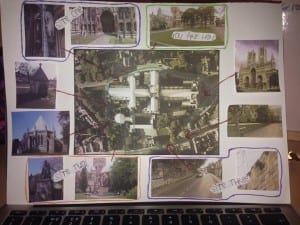There is so much difference and variety in the way we live our lives, but life takes us all on the same pathway which leads us all through the same stages of life. Regardless of our individuality, we all finish the journey at the same place.
During Rachael’s visit we ran through the script with her whilst she pretended to be an audience member. This was very helpful as she listened from a fresh outsiders point of view, and pointed out aspects of the script which didn’t make sense or needed tweaking in order for clear understanding. We spoke to her about our idea of having the famous Shakespearian monologue ‘all the world’s a stage’ playing as the audience make their way round the final leg of their journey back to the beginning. We wanted there to be an underlying message of the journey of life, and we thought that the words in that monologue reflect exactly what we wanted to portray. ‘First childness’ as a baby, and ‘second childness’ as an elderly person, in parallel with our tour starting at the picnic green and finishing there too. One interesting comment that Rachael mentioned was that the green where we are intending to have our starting picnic is actually a mass burial pit where bodies were dumped during the plague. This gave us the idea to remove the picnic blankets and anything lighthearted whilst the audience are on their journey. Therefore when they arrive back at the place they started, it is bare, empty and a reflection of the death that’s been underlying their journey from the start – much like the journey of life itself.
To ensure that this theme of the life cycle is evident and justified we needed to place audios or objects around the site that would represent adulthood and retirement between the Tennyson statue (childhood stage) and the final picnic green (death). We walked along the route and decided that adulthood could be represented by marriage, and we would use subtle coincidences to represent it. We are looking to scatter confetti on the ground on the corner of Minsters Yard where there will be another audio track, which is very different to the previous ones. This audio represents when we reach midlife, the crossroads where you question life and start on your inevitable decline. The audio will ask them to reflect upon their journey and ask a series of rhetorical questions with the sound of wedding bells in the background. Phrases such as ‘as your journey draws to a close’ and ‘you have reached the peak of your journey, please continue on towards the finish’ it echo’s the peak of adulthood. As well as adulthood we also focused on the elderly stage of life, the final stage, which will have audio that will be listened to when they reach the west face of the cathedral whilst they make their way back around to the green. We thought that this would be a good place to have the ‘all the worlds a stage’ speech and we are going to have an old man (my granddad) reading it. The last section in the speech talks about ‘second childness’ that we thought could be read by the girl who read the Cradle song. Representing the life cycle.

